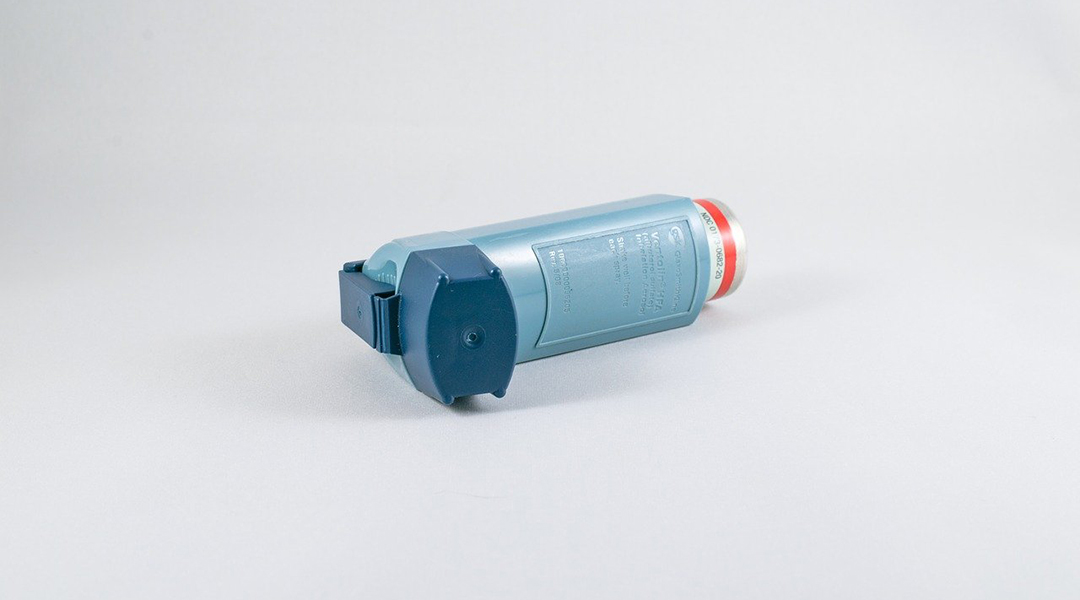Image credit: Bob Williams Pixabay
Steroid-based inhalers deliver life-saving medication for millions of asthma sufferers, providing relief and the ability to simply breathe. Unfortunately, inhalers do not work for all patients, and with rates on the rise for a disease that leads to hundreds of thousands of deaths world-wide each year, new asthma treatments and strategies are needed.
A team of UConn researchers — including Assistant Professor of Chemistry in the College of Liberal Arts and Sciences Jessica Rouge and Associate Professor of Pathobiology in the College of Agriculture, Health, and Natural Resources Steven Szczepanek — are collaborating to develop novel asthma therapeutics using gene-silencing nanocapsules in a bid to help patients who aren’t benefiting from existing treatments. Their research was published in ACS Nano.
“When treating asthma, many people think of small molecule anti-inflammatory medications as the way to go, but there are plenty of patients who have asthma who do not respond to corticosteroids,” says Rouge. “There’s an unmet need for creating different therapeutics that can suppress asthma for this group of people.”
Rouge’s research group, including co-authors Ph.D. student Shraddha Sawant and Alyssa Hartmann ’20 Ph.D., designs nanomaterials and targeted therapeutics that deliver gene silencing messages to cells. This paper details a nucleic acid nanocapsule (NAN) designed to selectively deliver an enzyme, called a DNAzyme, to silence a component of the immune response, called GATA-3, that leads to the over-expression of immune components that play a significant role in allergic asthma attacks.
Szczepanek explains there are different types of asthma, and this technology is designed to treat allergic asthma specifically, which constitutes about 50% of cases in adults and 90% in children. GATA-3-based treatments are already showing promise in clinical trials, and Rouge says that by pairing the sequence with nanotechnology, they hope to provide more efficient means of delivery and treatment straight to the source of inflammation.
“When using nanomaterials, we try to administer the therapy in a way that could allow us to use less materials to get a bigger effect,” Rouge says.
Their system is based on surfactants that assemble into micelles, similar to tiny bubbles, and occurs in a stepwise process, resulting in each being around 60 nanometers in size.
“First, we synthesize something called a surfactant, it’s much like soap and essentially forms a nanoscale bubble. Then we modify the surface chemistry of this bubble so it can conjugate or connect to DNA. The next step, and what’s unique to our lab, is we use enzymes to build the next piece to attach the DNA sequence that essentially cleaves mRNA encoding GATA-3,” Rouge says.
The nanocaspules were then characterized and checked if they could cleave the nucleic acid target cell lines in vitro and the results were promising.
“We showed these gene-silencing sequences were effectively delivered using our formulation and we saw that they knocked down the gene target of interest. That was an exciting first step,” says Rouge.
Rouge brought the data to Szczepanek to see if his research group, including co-authors and graduate students Tyler Gavitt ’21 Ph.D. and Arlind Mara ’21 Ph.D., who study respiratory pathogens and disease pathology, would be interested in collaborating on the next steps of research to see how technology performed in vivo and if it could be of clinical relevance.
Having studied asthma as part of his post-doctoral research, and with his lab equipped for taking the next steps, Szczepanek says the collaboration was a natural fit.
“I thought this gene silencing technology was a fantastic application for an asthma therapeutic.”
The researchers tested the GATA-3 DNAzyme-NAN efficacy in an allergic asthma mouse model sensitive to house dust mites. The results showed the lungs of mice treated with the NANs had less inflammatory damage compared to the untreated control group. The treatment also reduced the presence of inflammatory immune cells, called eosinophils, which contribute to airway obstruction (see side bar).
“Not only did we see a substantial reduction of asthma phenotypes in our mouse model, but we tested the GATA-3 DNAzyme-NANs in human white blood cells and saw both uptake of the nanoparticles and knock-down of expression of the gene of interest. This combination of data makes me really hopeful about the translational potential of the nanoparticles for human health,” says Szczepanek.
Rouge points out another important detail: “Generally speaking, when putting nanoparticles in our lungs, you might think they could cause inflammation. However, we were really excited that at doses we used, the nanocarrier alone didn’t cause inflammation.”
“I believe our unique nanoconstruct holds great promise in the field of oligonucleotide delivery,” says Sawant. “I am happy to be a part of this collaborative research as it marks the beginning of the development of the NAN as an effective in vivo nanocarrier.”
Rouge says the next step is to hopefully get NIH funding to continue the research: “We want to figure out, Where do these nanocapsules go? We need to do a biodistribution study and other logical next steps, like pharmacokinetics and determining how long these therapeutics last in an organism.”
The researchers were recently awarded a patent for the nanocapsule formulation, and they hope to commercialize it. Szczepanek explains the team envisions that, eventually, the technology could be delivered to the patient via an inhaler, like current asthma medications are and, depending on exactly how it is formulated, that it could target active inflammation or act as a prophylactic measure. Rouge adds that this technology has the potential to be customizable.
“The major theme is that different people respond differently to diseases in general, so there is the potential for personalized medicine. We are looking toward a paradigm shift because if you know the genetics of somebody in terms of the intensity or overexpression of a particular gene or if it is upregulated, we could treat it or at least depress it.”
Reference: Tyler Gavitt, et al., A GATA3 Targeting Nucleic Acid Nanocapsule for In Vivo Gene Regulation in Asthma, ASC Nano (2021). DOI: 10.1021/acsnano.0c07781; press release provided by University of Connecticut

















